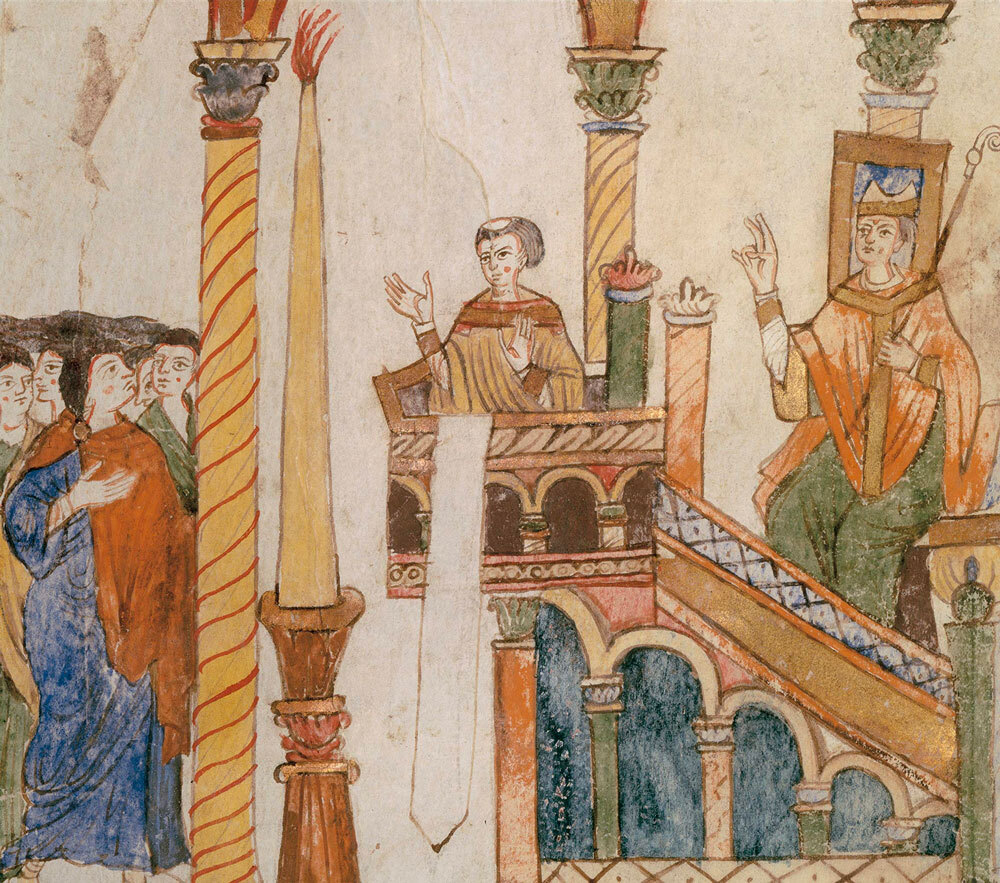
Every year, a priest, a liturgical cantor, or preferably a deacon prepares to chant the Exsultet (in Latin: Praeconium Paschale), also known as the Easter Proclamation. The word Exsultet, which means Rejoice, is a medieval hymn of praise. This liturgical chant is sung once only during the year in the liturgy of the Roman Rite, the night of the Easter Vigil.
The origin of the texts of the Exsultet, as we know it in the liturgy, traces back to the Medieval Era in Southern Italy, from the Exsultet Rolls that contained the poetic liturgical hymn. The Exsultet is one of the most majestic hymns of the Church. Without a doubt, the faithful look forward to hearing it, after the Lenten season every year, to praise God and to pray.
“In huius igitur noctis gratia, suscipe, sancte Pater laudis huius sacrificium vespertinum, quod tibi in haec cerei oblatione sollemni, per ministrorum manus de operibus apum, sacrosancta reddit ecclesia” (On this, your night of grace, O holy Father, accept this candle, a solemn offering, the work of bees and of your servants’ hands, an evening sacrifice of praise, this gift from your most holy Church).
Before the Exsultet is proclaimed, the Paschal Candle, The Light of Christ, is carried in a solemn nightly procession into the dark church, alluding to God’s plan of salvation in the Old Testament: “The LORD preceded them, in the daytime by means of a column of cloud to show them the way, and at night by means of a column of fire to give them light. Thus they could travel both day and night. Neither the column of cloud by day nor the column of fire by night ever left its place in front of the people” (Exodus 13:21-22). The Exsultet resounds a double indication: to the immolation of the true Lamb, whose blood consecrates the doors of the faithful, and the night of the liberation of Egypt through the Resurrection of Christ, and to Christ’s glorious passion and victory over death.
During the Lucernarium, the light of Christ guides us from the darkness to the light, when all things are renewed. From the light of the Paschal Candle, all of the members of the Church light their candles by sharing their flame. After this, they wait for the instance of the chant that announces the Resurrection of the Lord. Once the Paschal Candle is placed on its stand and is incensed, the deacon forcefully proclaims: “Gaudeat et tellus tantis irradiata fulgoribus et, aeterni regis splendore illustrata, totius orbis se sentiat amisisse caliginem” (Let the earth also be filled with joy, illuminated with such resplendent rays; and let men know that the darkness which overspread the whole world is chased away by the splendor of our eternal King).
Fr. Romano Guardini writes in his book The Spirit of the Liturgy: “Liturgical emotion is, however, exceedingly instructive. It has moments of supreme climax, in which all bounds are broken, as, for instance, in the limitless rejoicing of the Exsultet on Holy Saturday…The heart speaks powerfully, but thought at once takes the lead; the forms of prayer are elaborately constructed, the constituent parts carefully counterbalanced; and, as a rule, they deliberately keep emotion under strict control.”Because of this, the proclamation of the Exsultet, of the announcement of Easter, is a solemn and glorious liturgical moment, replete of signs and symbols, which should be witnessed in an atmosphere of faith, profound joy, reverence, full participation, and sacred silence, for as the liturgical hymn sings: “Haec nox est, in qua, destructis vinculis mortis, Christus ab inferis victor ascendit” (This is the night in which Christ broke the chains of death, and ascended conqueror from hell). It is the night when the praise of the Church for the history of salvation and the light of Christ redeems humanity from Genesis to the Apocalypse. Therefore, let us glorify God on this holy night for the victory of Christ, and for the victory of Christians

